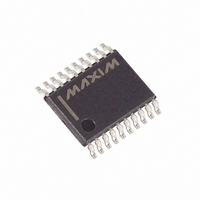MAX6689UP9A+ Maxim Integrated Products, MAX6689UP9A+ Datasheet - Page 6

MAX6689UP9A+
Manufacturer Part Number
MAX6689UP9A+
Description
IC TEMP MONITOR 7CH 20TSSOP
Manufacturer
Maxim Integrated Products
Datasheet
1.MAX6689UP9A.pdf
(19 pages)
Specifications of MAX6689UP9A+
Function
Temp Monitoring System (Sensor)
Topology
ADC, Buffer, Register Bank
Sensor Type
External & Internal
Sensing Temperature
-40°C ~ 125°C, External Sensor
Output Type
I²C™/SMBus™
Output Alarm
Yes
Output Fan
Yes
Voltage - Supply
3 V ~ 5.5 V
Operating Temperature
-40°C ~ 125°C
Mounting Type
Surface Mount
Package / Case
20-TSSOP
Full Temp Accuracy
+/- 1 C, +/- 3 C
Digital Output - Bus Interface
Serial (2-Wire)
Digital Output - Number Of Bits
11 bit
Maximum Operating Temperature
+ 125 C
Minimum Operating Temperature
- 40 C
Lead Free Status / RoHS Status
Lead free / RoHS Compliant
The MAX6689 is a precision multichannel temperature
monitor that features one local and six remote tempera-
ture-sensing channels with a programmable alert
threshold for each temperature channel and a program-
mable overtemperature threshold for channels 1, 4, 5,
and 6 (see Figure 1). Communication with the MAX6689
is achieved through the SMBus serial interface and a
dedicated alert pin. The alarm outputs, OVERT and
ALERT, assert if the software-programmed temperature
thresholds are exceeded. ALERT typically serves as an
interrupt, while OVERT can be connected to a fan, sys-
tem shutdown, or other thermal-management circuitry.
In the default conversion mode, the MAX6689 starts the
conversion sequence by measuring the temperature on
channel 1, followed by 2, 3, local channel, 4, 5, and 6.
The conversion result for each active channel is stored
in the corresponding temperature data register.
In some systems, one of the remote thermal diodes may
be monitoring a location that experiences temperature
changes that occur much more rapidly than in the other
channels. If faster temperature changes must be moni-
tored in one of the temperature channels, the MAX6689
7-Channel Precision Temperature Monitor
6
_______________________________________________________________________________________
PIN
10
11
12
13
14
15
16
17
18
19
20
9
SMBDATA
SMBCLK
OVERT
ALERT
NAME
DXN5
DXN6
DXP5
DXP6
STBY
GND
N.C.
V
CC
ADC Conversion Sequence
Detailed Description
Combined Current Source and A/D Positive Input for Channel 5 Remote Diode. Connect to the anode
of a remote-diode-connected temperature-sensing transistor. Leave floating or connect to V
remote diode is used. Place a 2200pF capacitor between DXP5 and DXN5 for noise filtering.
Cathode Input for Channel 5 Remote Diode. Connect the cathode of the channel 1 remote-diode-
connected transistor to DXN5.
Cathode Input for Channel 6 Remote Diode. Connect the cathode of the channel 1 remote-diode-
connected transistor to DXN6.
Combined Current Source and A/D Positive Input for Channel 6 Remote Diode. Connect to the anode
of a remote-diode-connected temperature-sensing transistor. Leave floating or connect to V
remote diode is used. Place a 2200pF capacitor between DXP6 and DXN6 for noise filtering.
Active-Low Standby Input. Drive STBY logic-low to place the MAX6689 in standby mode, or logic-high
for operate mode. Temperature and threshold data are retained in standby mode.
No Connection. Must be connected to ground.
Overtemperature Active-Low, Open-Drain Output. OVERT asserts low when the temperature of
channels 1, 4, 5, and 6 exceeds the programmed threshold limit.
Supply Voltage Input. Bypass to GND with a 0.1µF capacitor.
SMBus Alert (Interrupt), Active-Low, Open-Drain Output. ALERT asserts low when the temperature of
any channel exceeds the programmed ALERT threshold.
SMBus Serial-Data Input/Output. Connect to a pullup resistor.
SMBus Serial-Clock Input. Connect to a pullup resistor.
Ground
allows channel 1 to be monitored at a faster rate than
the other channels. In this mode (set by writing a 1 to bit
4 of the configuration 1 register), measurements of
channel 1 alternate with measurements of the other
channels. The sequence becomes channel 1, channel
2, channel 1, channel 3, channel 1, etc. Note that the
time required to measure all seven channels is consid-
erably greater in this mode than in the default mode.
Enter software standby mode by setting the STOP bit to
1 in the configuration 1 register. Enter hardware standby
by pulling STBY low. Software standby mode disables
the ADC and reduces the supply current to approxi-
mately 30µA. Hardware standby mode halts the ADC
clock, but the supply current is approximately 350µA.
During either software or hardware standby, data is
retained in memory. During hardware standby, the
SMBus interface is inactive. During software standby, the
SMBus interface is active and listening for commands.
The timeout is enabled if a start condition is recognized
on SMBus. Activity on the SMBus causes the supply cur-
rent to increase. If a standby command is received while
a conversion is in progress, the conversion cycle is inter-
FUNCTION
Pin Description (continued)
Low-Power Standby Mode
CC
CC
if no
if no











